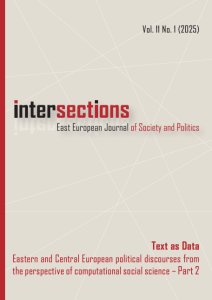What else comes with a geographical concept beyond geography?
The renaissance of the term ‘Carpathian Basin’ in the Hungarian Parliament
Renáta Németh – Eszter Katona – Péter Balogh – Zsófia Rakovics – Anna Unger
Abstract
A key tenet from research on geographical concepts is that these are never neutral but filled with different ideas and agendas. The ‘Carpathian Basin’ is one of the most significant concepts in Hungarian geographical thought, but its recently reemerging use in political discourse has not yet been studied through quantitative text analysis.
In this paper, we describe how a structural topic model was used to analyze the 1,525 speeches containing the term delivered in the Hungarian Parliament between 1998 and 2020.
Our results indicate a renaissance in the use of the term, both in terms of its more frequent use and its discursive meaning as a sign of a turn in national policy. At the same time, ‘Carpathian Basin’ discourse serves as a symbolic battleground for different political ideologies to indicate both neutral geographical references and nationalist sentiments. Left-liberals tend to use it politically neutrally, referring to an ethno-culturally heterogeneous area, and using a less personal voice, referring to institutions and interests. In contrast, right-wing narratives often demarcate the Carpathian Basin as a single geographical entity. Some of these speeches exhibit virtual nationalism, while others subtly question territorial legitimacy. The latter MPs speak in terms of representing their own community, referring to values, emotions, and culture, offering a collective identity to which people attach values and emotions.
Keywords: natural language processing, structural topic model, Carpathian Basin, Hungarian Parliament, ideological divides
Sharing political news online:
A network model of information spread on Facebook
Emese Túry-Angyal – László Lőrincz
Abstract
Social media plays a crucial role in online political campaigns as political parties can reach, inform, and mobilize voters through these platforms. Political campaigns share information on social media to mobilize support, and prior research shows that sharing content on social media correlates with the offline popularity of political parties. In this paper, we model the spread of political content on the internet. We start by exploring popularity and sharing behavior related to posts by Hungarian politicians on Facebook. We utilize this analysis to build an agent-based model. Within this, we test how echo chambers, homophily, and network structure affect the number of shares that contribute to information diffusion on social media. Our simulation compares spreading in different network structures and shows that preferential attachment models are not the most efficient for fostering diffusion in networks with relatively low density or when a filtering mechanism is present. Our model confirms that homophily generally has a positive effect on diffusion, especially within echo chambers. Echo chambers enhance the diffusion of political news with a limited potential audience. Furthermore, the results of our agent-based simulation indicate that homophily and echo chambers can significantly influence the spread of political content on social media, with echo chambers particularly enhancing diffusion in networks where overall diffusion is low.
Keywords: social media, political participation, agent-based model



